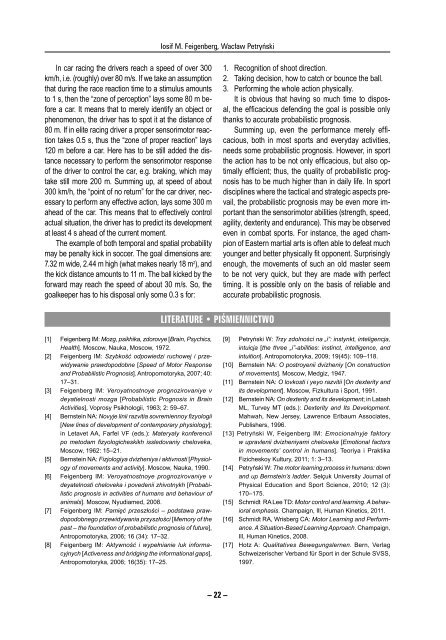Antropomotoryka nr 55.indb - Akademia Wychowania Fizycznego w ...
Antropomotoryka nr 55.indb - Akademia Wychowania Fizycznego w ...
Antropomotoryka nr 55.indb - Akademia Wychowania Fizycznego w ...
You also want an ePaper? Increase the reach of your titles
YUMPU automatically turns print PDFs into web optimized ePapers that Google loves.
Iosif M. Feigenberg, Wacław Petryński<br />
In car racing the drivers reach a speed of over 300<br />
km/h, i.e. (roughly) over 80 m/s. If we take an assumption<br />
that during the race reaction time to a stimulus amounts<br />
to 1 s, then the “zone of perception” lays some 80 m before<br />
a car. It means that to merely identify an object or<br />
phenomenon, the driver has to spot it at the distance of<br />
80 m. If in elite racing driver a proper sensorimotor reaction<br />
takes 0.5 s, thus the “zone of proper reaction” lays<br />
120 m before a car. Here has to be still added the distance<br />
necessary to perform the sensorimotor response<br />
of the driver to control the car, e.g. braking, which may<br />
take still more 200 m. Summing up, at speed of about<br />
300 km/h, the “point of no return” for the car driver, necessary<br />
to perform any effective action, lays some 300 m<br />
ahead of the car. This means that to effectively control<br />
actual situation, the driver has to predict its development<br />
at least 4 s ahead of the current moment.<br />
The example of both temporal and spatial probability<br />
may be penalty kick in soccer. The goal dimensions are:<br />
7.32 m wide, 2.44 m high (what makes nearly 18 m 2 ), and<br />
the kick distance amounts to 11 m. The ball kicked by the<br />
forward may reach the speed of about 30 m/s. So, the<br />
goalkeeper has to his disposal only some 0.3 s for:<br />
1. Recognition of shoot direction.<br />
2. Taking decision, how to catch or bounce the ball.<br />
3. Performing the whole action physically.<br />
It is obvious that having so much time to disposal,<br />
the efficacious defending the goal is possible only<br />
thanks to accurate probabilistic prognosis.<br />
Summing up, even the performance merely efficacious,<br />
both in most sports and everyday activities,<br />
needs some probabilistic prognosis. However, in sport<br />
the action has to be not only efficacious, but also optimally<br />
efficient; thus, the quality of probabilistic prognosis<br />
has to be much higher than in daily life. In sport<br />
disciplines where the tactical and strategic aspects prevail,<br />
the probabilistic prognosis may be even more important<br />
than the sensorimotor abilities (strength, speed,<br />
agility, dexterity and endurance). This may be observed<br />
even in combat sports. For instance, the aged champion<br />
of Eastern martial arts is often able to defeat much<br />
younger and better physically fit opponent. Surprisingly<br />
enough, the movements of such an old master seem<br />
to be not very quick, but they are made with perfect<br />
timing. It is possible only on the basis of reliable and<br />
accurate probabilistic prognosis.<br />
LITERATURE • PIŚMIENNICTWO<br />
[1] Feigenberg IM: Mozg, psikhika, zdorovye [Brain, Psychics,<br />
Health]. Moscow, Nauka, Moscow, 1972.<br />
[2] Feigenberg IM: Szybkość odpowiedzi ruchowej i przewidywanie<br />
prawdopodobne [Speed of Motor Response<br />
and Probabilistic Prognosis]. <strong>Antropomotoryka</strong>, 2007; 40:<br />
17–31.<br />
[3] Feigenberg IM: Veroyatnostnoye prognozirovaniye v<br />
deyatielnosti mozga [Probabilistic Prognosis in Brain<br />
Activities], Voprosy Psikhologii, 1963; 2: 59–67.<br />
[4] Bernstein NA: Novyje linii razvitia sovremiennoy fizyologii<br />
[New lines of development of contemporary physiology];<br />
in Letavet AA, Farfel VF (eds.): Materyaly konferencii<br />
po metodam fi zyologicheskikh issledovaniy cheloveka,<br />
Moscow, 1962: 15–21.<br />
[5] Bernstein NA: Fizjologiya dvizheniya i aktivnosti [Physiology<br />
of movements and activity]. Moscow, Nauka, 1990.<br />
[6] Feigenberg IM: Veroyatnostnoye prognozirovaniye v<br />
deyatelnosti cheloveka i povedenii zhivotnykh [Probabilistic<br />
prognosis in activities of humans and behaviour of<br />
animals]. Moscow, Nyudiamed, 2008.<br />
[7] Feigenberg IM: Pamięć przeszłości – podstawa prawdopodobnego<br />
przewidywania przyszłości [Memory of the<br />
past – the foundation of probabilistic prognosis of future],<br />
<strong>Antropomotoryka</strong>, 2006; 16 (34): 17–32.<br />
[8] Feigenberg IM: Aktywność i wypełnianie luk informacyjnych<br />
[Activeness and bridging the informational gaps],<br />
<strong>Antropomotoryka</strong>, 2006; 16(35): 17–25.<br />
[9] Petryński W: Trzy zdolności na „i”: instynkt, inteligencja,<br />
intuicja [the three „i”-abilities: instinct, intelligence, and<br />
intuition]. <strong>Antropomotoryka</strong>, 2009; 19(45): 109–118.<br />
[10] Bernstein NA: O postroyenii dvizheniy [On construction<br />
of movements]. Moscow, Medgiz, 1947.<br />
[11] Bernstein NA: O lovkosti i yeyo razvitii [On dexterity and<br />
its development]. Moscow, Fizkultura i Sport, 1991.<br />
[12] Bernstein NA: On dexterity and its development; in Latash<br />
ML, Turvey MT (eds.): Dexterity and Its Development.<br />
Mahwah, New Jersey, Lawrence Erlbaum Associates,<br />
Publishers, 1996.<br />
[13] Petryński W, Feigenberg IM: Emocionalnyje faktory<br />
w upravlenii dvizheniyami cheloveka [Emotional factors<br />
in movements’ control in humans]. Teoriya i Praktika<br />
Fizicheskoy Kultury, 2011; 1: 3–13.<br />
[14] Petryński W: The motor learning process in humans: down<br />
and up Bernstein’s ladder. Selçuk University Journal of<br />
Physical Education and Sport Science, 2010; 12 (3):<br />
170–175.<br />
[15] Schmidt RA Lee TD: Motor control and learning. A behavioral<br />
emphasis. Champaign, Ill, Human Kinetics, 2011.<br />
[16] Schmidt RA, Wrisberg CA: Motor Learning and Performance.<br />
A Situation-Based Learning Approach. Champaign,<br />
Ill, Human Kinetics, 2008.<br />
[17] Hotz A: Qualitatives Bewegungslernen. Bern, Verlag<br />
Schweizerischer Verband für Sport in der Schule SVSS,<br />
1997.<br />
– 22 –





![Antropomotoryka nr 57 [2012]. - Akademia Wychowania Fizycznego ...](https://img.yumpu.com/50213388/1/182x260/antropomotoryka-nr-57-2012-akademia-wychowania-fizycznego-.jpg?quality=85)











